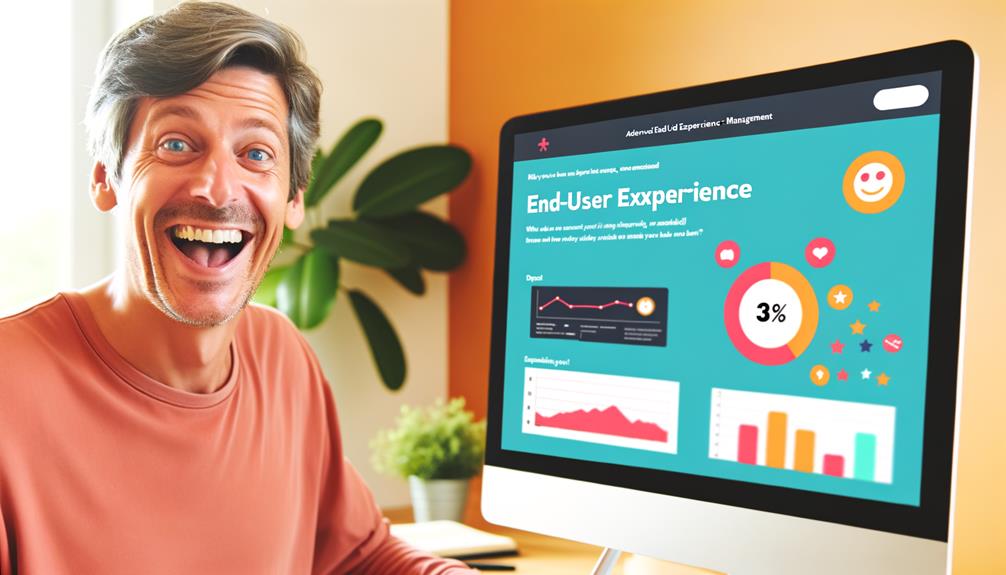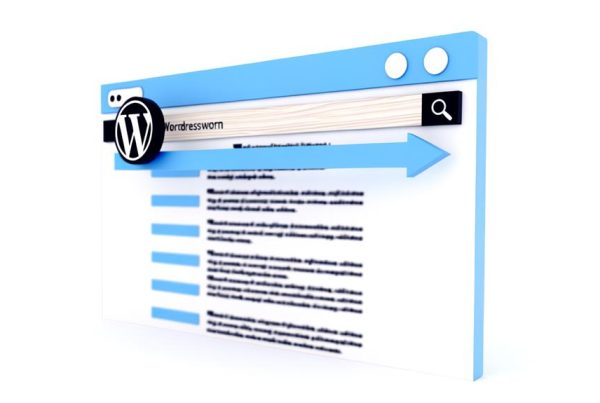We all know that 88% of online consumers are less likely to return to a site after a bad experience, and that's where End-User Experience Monitoring (EUEM) comes into play.
Implementing EUEM is essential for businesses looking to stay ahead in the digital landscape, but where do you start?
In this discussion, we'll uncover the ins and outs of EUEM, from understanding its significance in identifying and resolving IT issues to exploring the key metrics and tools that drive optimal user experiences.
Join us as we unravel the tips and strategies for implementing EUEM to elevate customer satisfaction, enhance brand reputation, and gain a competitive edge.
Understanding End-User Experience Monitoring

End-user experience monitoring (EUEM) is an essential practice for IT professionals and businesses aiming to prioritize user satisfaction and optimize digital experiences. EUEM tracks how people directly interact with websites or applications, allowing us to identify pain points and prioritize fixes.
By capturing real-time data on customer interactions, tools like Cisco AppDynamics help us provide efficient solutions to customer issues. Metrics such as response rate, page load time, and bounce rate provide crucial insights into website performance, allowing us to address technical issues promptly.
Choosing the right EUEM tool and setting clear goals and metrics are vital for improving IT operations and customer satisfaction. Ultimately, EUEM enhances brand reputation, increases revenue, and keeps businesses ahead of competitors by providing insights into user preferences.
Importance of EUEM Metrics
Understanding the critical importance of EUEM metrics is essential for optimizing digital experiences and continuously improving customer satisfaction and business success.
EUEM metrics provide valuable insights into end-user interactions, allowing businesses to identify performance bottlenecks, prioritize fixes, and enhance overall user experience. Metrics such as response rate, page load time, bounce rate, network latency, and device type offer strategic data points for addressing usability issues and improving customer engagement.
Key EUEM Tools

Selecting the appropriate EUEM tool is crucial for optimizing end-user experiences and improving overall business success.
Cisco AppDynamics offers powerful EUEM capabilities, capturing real-time data on customer interactions to identify and resolve technical issues promptly.
CMS Hub provides a comprehensive website platform with built-in end-user experience monitoring tools.
Catchpoint is a transactional monitoring tool that offers a complete view of the customer experience.
Logic Monitor integrates AI for basic synthetic monitoring and service availability tracking.
These tools equip organizations with the insights needed to enhance user experiences and address performance issues efficiently.
Selecting the Right EUEM Tool
We will strategically evaluate and choose the most suitable EUEM tool to optimize end-user experiences and enhance overall business success.
Considerations for Selecting the Right EUEM Tool:
- Assess the scalability and flexibility of the tool to adapt to our evolving business needs.
- Evaluate the comprehensiveness of the tool's monitoring metrics and its ability to provide actionable insights.
This strategic approach will ensure that the selected EUEM tool aligns with our organizational objectives and empowers us to proactively address end-user experience challenges.
Implementing EUEM Best Practices

Our strategic evaluation and selection of the most suitable EUEM tool has paved the way for implementing best practices that will optimize end-user experiences and drive overall business success.
We're integrating EUEM into our operations to improve IT and customer satisfaction. By defining clear goals and metrics, choosing appropriate monitoring tools, and regularly analyzing data, we're ensuring an enhanced user experience.
Collaboration with different teams to address performance issues and continuous optimization based on monitoring results are key elements of our EUEM best practices.
With these strategies in place, we're confident in our ability to deliver exceptional end-user experiences and achieve our business objectives.
Maximizing Business Impact
To maximize the business impact of our end-user experience monitoring implementation, we'll focus on leveraging actionable insights to drive strategic decision-making and sustainable growth.
- Actionable Insights: Utilize real-time data to identify trends and patterns, enabling proactive problem-solving.
- Implement machine learning algorithms to predict potential issues and opportunities.
- Leverage user behavior analytics to tailor products and services to customer preferences.
Leveraging EUEM for Customer Satisfaction

Maximizing the business impact of our end-user experience monitoring implementation, we'll harness actionable insights to elevate customer satisfaction and drive sustainable growth through strategic decision-making.
By leveraging EUEM, we can proactively identify and address potential pain points in the customer journey, ensuring a seamless and satisfying experience. This strategic approach not only fosters customer loyalty but also leads to increased conversion rates and revenue.
With the ability to optimize user experience based on real-time monitoring results, we empower our organization to stay ahead of competitors and enhance our brand reputation and credibility.
Through EUEM, we liberate our business from potential usability issues, positioning ourselves as industry leaders committed to delivering exceptional customer satisfaction.
EUEM for Enhanced User Engagement
Implementing End-User Experience Monitoring (EUEM) for enhanced user engagement requires a strategic approach to leverage actionable insights and drive sustainable growth.
To achieve this, we must:
- Utilize EUEM data to understand user behavior and preferences
- Analyze user interactions and identify patterns
- Tailor user engagement strategies based on insights gained
Enhanced user engagement is essential for fostering a loyal customer base and driving business success. By proactively monitoring and optimizing the end-user experience, we can create meaningful interactions, increase user satisfaction, and ultimately enhance user engagement.
This strategic use of EUEM allows us to stay ahead of competitors and solidify our brand's reputation, positioning us as leaders in providing exceptional user experiences.
Continuous Improvement Through EUEM

Continuous improvement through End-User Experience Monitoring (EUEM) requires a proactive approach to analyzing and optimizing user interactions for sustained business growth.
By constantly evaluating and acting on user feedback and performance metrics, we can ensure that our digital platforms evolve in line with user needs and expectations. This approach empowers us to stay ahead of the competition, enhance customer satisfaction, and drive revenue growth.
Continuous improvement through EUEM enables us to address pain points, identify opportunities for enhancement, and make data-driven decisions to optimize the user experience.
As we strive for excellence, our commitment to ongoing improvement through EUEM will solidify our position as industry leaders, fostering trust and loyalty among our user base.
Frequently Asked Questions
How Does End-User Experience Monitoring Impact the Overall User Journey and Satisfaction With a Product or Service?
Improving end-user experience monitoring positively impacts the overall user journey and satisfaction. It allows us to identify and address usability issues, leading to higher customer satisfaction, loyalty, and increased conversion rates.
What Are Some Best Practices for Integrating End-User Experience MonIToring Into Existing IT Operations and Workflows?
Integrating end-user experience monitoring into existing IT operations and workflows requires strategic planning and collaboration.
We choose appropriate EUEM tools aligned with our organizational needs and define clear goals and metrics to measure user experience.
Regular analysis, interpretation, and collaboration with different teams help address performance issues.
Continuous optimization and improvement of the user experience based on monitoring results ensure higher customer satisfaction, loyalty, and business success.
How Does End-User Experience Monitoring Contribute to Identifying and Addressing Potential Security Vulnerabilities in Digital Products or Services?
End-user experience monitoring contributes to identifying and addressing potential security vulnerabilities in digital products or services. It does this by detecting abnormal user behavior, unauthorized access attempts, and suspicious network activity.
By analyzing user interactions, EUEM tools can pinpoint unauthorized access patterns and identify potential security threats. This allows IT professionals to proactively address vulnerabilities and enhance overall security measures.
This proactive approach ensures a secure and reliable digital experience for users.
What Are Some Common Challenges or Obstacles Organizations Face When Implementing End-User Experience Monitoring, and How Can They Be Overcome?
When implementing end-user experience monitoring, organizations often face challenges such as tool selection, defining clear metrics, and cross-team collaboration.
We overcome these obstacles by carefully assessing our needs, setting specific goals, and choosing tools that align with our objectives.
Regular data analysis and collaboration across teams are essential for addressing performance issues and continuously improving user experience.
Our strategic approach ensures effective implementation and fosters a culture of customer-centricity.
How Can End-User Experience Monitoring Be Leveraged to Inform Strategic Business Decisions and Drive Long-Term Growth and Success?
End-user experience monitoring can be leveraged to inform strategic business decisions and drive long-term growth and success.
By analyzing real-time user interactions and performance metrics, we gain valuable insights into customer preferences and pain points. This data empowers us to make informed decisions that enhance user experience, increase customer satisfaction, and boost brand reputation.
Leveraging end-user experience monitoring strategically positions our business for sustained growth and success.
Conclusion
In conclusion, implementing end-user experience monitoring is essential for businesses to proactively identify and address IT issues. This ultimately leads to improved customer satisfaction and business success.
By leveraging the right EUEM tools and metrics, organizations can enhance their brand reputation, customer loyalty, and competitive edge in the digital experience industry.
Embracing EUEM is a strategic move that will undoubtedly maximize the impact on business performance and customer engagement.


![What Is End-User Experience Monitoring? [Tips For Implementing It]](https://www.honestwebs.com/wp-content/uploads/2023/12/understanding_and_monitoring_user_experience.jpg)




